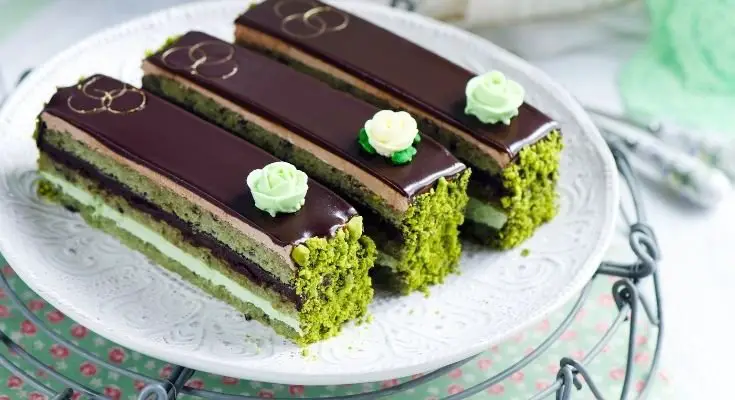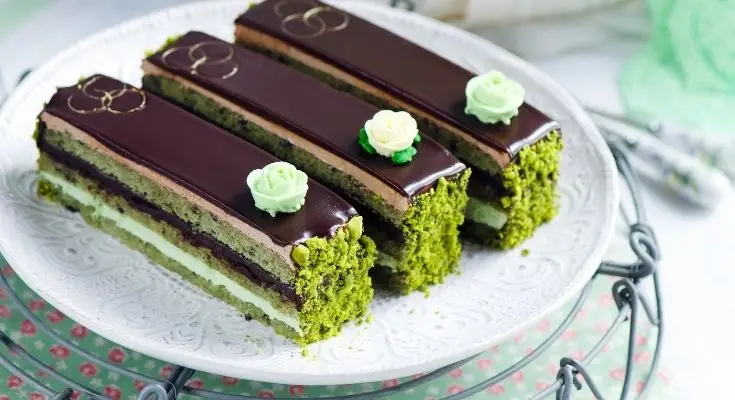French confection known as opera cake. Layers of coffee-soaked almond sponge cake, coffee French buttercream, and chocolate icing are sandwiched between layers of the cake. The layers that resemble the tiers of an opera theatre are where its name comes from. The basic components of Opera Cake are sponge cake, coffee syrup, ganache, coffee buttercream, and chocolate glaze.

Classic Opera Cake Recipe
Ingredients
Jaconde Sponge
Coffee Syrup
- 1 tablespoon instant espresso powder
- 5 tablespoon warm water
- 1/4 cup granulated sugar
- 3 tablespoon brandy or cognac
French Coffee Buttercream
- 1 tablespoon instant espresso powder
- 1 tablespoon water
- 3/4 cup granulated sugar
- 4 pic egg yolks
- 1 cup unsalted butter cubed and softened
Chocolate Glaze and Topping
- 6 tablespoons unsalted butter
- 7 oz. semisweet chocolate chopped fine
Modeling Chocolate Decors
- 10 oz. semisweet chocolate chips
- 1/3 cup light corn syrup
- luster dust gold
Instructions
Jaconde Sponge
- Turn the oven on to 450 degrees. Grease the parchment paper, line a 1711 jelly roll pan with it, then lightly grease the pan (alternatively, use a Silpat and grease the mat).
- Mix the almond flour, confectioners' sugar, all-purpose flour, whole eggs, and egg yolk in a stand mixer using the paddle attachment until well incorporated. When necessary, pause to scrape the bowl's sides clean.
- Whip the egg whites and fine sugar in a another basin using an electric hand mixer until a rich, glossy meringue forms. Gently incorporate the meringue into the mixture of almonds. Be careful not to deflate the batter as you carefully fold in the melted butter. Pour into the baking pan that has been prepared and spread evenly with an offset spatula. Bake for 5-7 minutes, or until the middle of the cake springs back when touched. Take out of the oven, then allow it cool somewhat. If the cake doesn't release from the pan's sides, slide a knife between the cake's edge and the pan to loosen the sponge.
- After carefully removing the paper or silicone liner, invert the cake onto a wire rack. Using a tiny, sharp knife, gently trim the cake's browned edges away. Place aside and allow to fully cool.
Coffee Syrup
- 1 tablespoon of water and the espresso powder are combined. Shake until dissolved. Granulated sugar and the remaining water are added to a pot. Stirring while bringing to a boil will melt the sugar. After taking it off the heat, whisk in the cognac or brandy and espresso. Allow to to room temperature.
French Coffee Buttercream
- Espresso powder should be thoroughly mixed with one tablespoon of water. Bring the remaining water and sugar to a boil in a saucepan while stirring until the sugar dissolves. Attach a thermometer to the pan's side and heat without stirring until the liquid reaches a boil. Use a pastry brush soaked in cold water to remove any crystals that may develop on the pan's sides. Cook, and once it reaches 238°F (the soft ball candy stage), turn off the heat.
- Egg yolks should be whipped for one minute in the bowl of an electric mixer with the whip attachment. Add the heated sugar syrup to the yolks in a slow, fine stream while the mixer is running (avoid getting the syrup on the sides of the bowl, aim for the middle). When the espresso mixture has entirely dissolved, add it and whip quickly until it has. It can appear that the mixture is liquid and nothing like buttercream. That is typical. Once the mixing bowl is cool to the touch, switch to the paddle attachment and slowly add the butter pieces while the mixer is running. It's natural for the mixture to start to look curdled; keep mixing. After adding all of the butter, beat vigorously.
Chocolate Glaze and Topping
- Melt the butter and 6 ounces of the chocolate in a large microwave-safe bowl (keep the remaining 2 tablespoons/1 ounce of chopped chocolate), which should take 1 to 1 minute 30 seconds in a typical home microwave. Gently whisk the ingredients to make it smooth. Stir in the final 2 tablespoons of chocolate until melted. Allow to thicken to a spreading consistency at room temperature, or hasten setting by cooling. If cooling, stir the mixture often.
Assemble the Cake
- Exactly divide the cake into thirds (I recommend using a ruler). With a pastry brush, spread the coffee syrup evenly over a layer that has been placed on a serving plate. Over the soaked sponge, evenly distribute half of the French buttercream. Add a second layer of sponge on top and drizzle some coffee syrup over it. Over the moistened sponge, drizzle half of the chocolate glaze. Add the remaining sponge cake on top, then drizzle with coffee syrup. Spread the borders with the remaining French buttercream after adding it. Cool the cake for about 30 minutes, or until the buttercream is set.
- In the microwave, reheat the remaining chocolate glaze for 15 seconds, or until it is sparkly and pourable but not hot. Spread the glaze evenly over the cake's top after pouring it on. Firm up by cooling.
- Trim the cake's edges to make them neater when it has firmed up. Slices into fingers, equally (about 2 inches wide). Decorate as desired; instructions for the gold laurel are below.
Modeling Chocolate Decors
- In a microwave-safe bowl, microwave the chocolate chips on full power for 30 second intervals, stirring well between each heating. Add the corn syrup once the chips are smooth and whisk until the liquid is thick and the chocolate has lost its sheen. A second layer of wax paper should be placed on top of the mixture before being carefully rolled flat with a rolling pin. Let stand for 1-2 hours until stiff.
- Take the paper from the surface and work the chocolate into a putty-like consistency. Fill the candy mold completely with tiny pieces of chocolate clay. To make the chocolate in the mold flat and even with the surface of the mold, trim the extra chocolate away with a knife. For 10 minutes, freeze. Gently remove and allow to cool to room temperature. Continue until you have as many medals as there are pieces of cake (about 5-6).
- Brush luster dust carefully over the high points of the ornamental laurels using a dry art brush. The backs of the laurels should be coated with corn syrup before being attached to the tops of the opera cake slices. Cake should be kept in the refrigerator until ready to serve. Before serving, bring to room temperature.
Notes
- Total Fat 49g 63%
- Saturated Fat 25g 125%
- Cholesterol 184mg 61%
- Sodium 245mg 11%
- Total Carbohydrate 43g 16%
- Dietary Fiber 6g 21%
- Total Sugars 31g
- Protein 13g
- Vitamin C 0mg 0%
- Calcium 107mg 8%
- Iron 5mg 30%
- Potassium 402mg 9%
Final Thought:
opera gâteau. This six-layer confection is a coffee lover’s dream come true, with layers of French buttercream and butter ganache alternated with three layers of almond sponge that have been moistened with espresso syrup. It has been called “elaborate,” which is accurate. It requires your time, patience, and a candy thermometer to prepare, but the result is incredibly rewarding. It is one of my all-time favorite cakes, and if you want to improve your patisserie abilities, you should attempt it.
